One-Step Synthesis of Highly Efficient Oligo(phenylphosphonic Dihydroxypropyl Silicone Oil) Flame Retardant for Polycarbonate
Abstract
:1. Introduction
2. Materials and Methods
2.1. Materials
2.2. Synthesis of Oligo(Phenylphosphonic Dihydroxypropyl Silicone Oil)
2.3. Preparation of Flame-Retardant PC Blends
2.4. Characterization
3. Results and Discussion
3.1. Structural Characterization of PPSO
3.2. Flame Retardancy
3.3. Thermal Degradation
3.4. Fire Behavior of PC-Based Blends
3.5. Flame Retardant Mechanism
4. Conclusions
Author Contributions
Funding
Acknowledgments
Conflicts of Interest
References
- Wang, T.; Yan, M.; Sun, X.; Quan, D. The mechanical and biological properties of polycarbonate-modified F127 hydrogels after incorporating active pendent double-bonds. Polymer 2015, 57, 21–28. [Google Scholar] [CrossRef]
- Arjun, G.N.; Ramesh, P. Structural characterization, mechanical properties, and in vitro cytocompatibility evaluation of fibrous polycarbonate urethane membranes for biomedical applications. J. Biomed. Mater. Res. 2012, 100, 3042–3050. [Google Scholar] [CrossRef] [PubMed]
- Levchik, S.V.; Weil, E.D. Overview of recent developments in the flame retardancy of polycarbonates. Polym. Int. 2005, 54, 981–988. [Google Scholar] [CrossRef]
- Jang, B.N.; Wilkie, C.A. A TGA/FTIR and mass spectral study on the thermal degradation of bisphenol A polycarbonate. Polym. Degrad. Stab. 2004, 86, 419–430. [Google Scholar] [CrossRef]
- Huang, K.; Yao, Q. Rigid and steric hindering bisphosphate flame retardants for polycarbonate. Polym. Degrad. Stab. 2015, 113, 86–94. [Google Scholar] [CrossRef]
- Feng, J.; Hao, J.; Du, J.; Yang, R. Flame retardancy and thermal properties of solid bisphenol A bis(diphenyl phosphate) combined with montmorillonite in polycarbonate. Polym. Degrad. Stab. 2010, 95, 2041–2048. [Google Scholar] [CrossRef]
- Zhao, W.; Li, B.; Xu, M.; Yang, K.; Lin, L. Novel intumescent flame retardants: Synthesis and application in polycarbonate. Fire Mater. 2013, 37, 530–546. [Google Scholar] [CrossRef]
- Weil, E.D.; Levchik, S.V. Flame retardants in commercial use or development for polyolefins. J. Fire Sci. 2008, 26, 5–43. [Google Scholar] [CrossRef]
- Hu, Z.; Chen, L.; Zhao, B.; Luo, Y.; Wang, D.Y.; Wang, Y.Z. A novel efficient halogen-free flame retardant system for polycarbonate. Polym. Degrad. Stab. 2011, 96, 320–327. [Google Scholar] [CrossRef]
- Bozi, J.; Czégény, Z.; Meszaros, E.; Blazso, M. Thermal decomposition of flame retarded polycarbonates. J. Anal. Appl. Pyrolysis 2007, 79, 337–345. [Google Scholar] [CrossRef]
- Ishikawa, T.; Maki, I.; Koshizuka, T.; Ohkawa, T.; Takeda, K. Effect of perfluoroalkane sulfonic acid on the flame retardancy of polycarbonate. J. Macromol. Sci. Part A 2004, 41, 523–535. [Google Scholar] [CrossRef]
- Feng, J.; Hao, J.; Du, J. Some developments in halogen-free flame retardancy of polycarbonate and its blends. In Fire and Polymers VI: New Advances in Flame Retardant Chemistry and Science; American Chemical Society: Washington, DC, USA, 2012; Volume 1118, pp. 113–122. [Google Scholar]
- Jiang, J.C.; Wang, Y.B.; Luo, Z.L. Design and application of highly efficient flame retardants for polycarbonate combining the advantages of cyclotriphosphazene and silicone oil. Polymers 2019, 11, 1155. [Google Scholar] [CrossRef] [PubMed]
- Lu, S.Y.; Hamerton, I. Recent developments in the chemistry of halogen-free flame retardant polymers. Prog. Polym. Sci. 2002, 27, 1661–1712. [Google Scholar] [CrossRef]
- Ding, H.; Huang, K.; Li, S.; Xu, L.; Xia, J.; Li, M. Flame retardancy and thermal degradation of halogen-free flame-retardant biobased polyurethane composites based on ammonium polyphosphate and aluminium hypophosphite. Polym. Test. 2017, 62, 325–334. [Google Scholar] [CrossRef]
- Mauerer, O. New reactive, halogen-free flame retardant system for epoxy resins. Polym. Degrad. Stab. 2005, 88, 70–73. [Google Scholar] [CrossRef]
- Rault, F.; Giraud, S.; Salaün, F.; Almeras, X. Development of a halogen free flame retardant masterbatch for polypropylene fibers. Polymers 2015, 7, 220–234. [Google Scholar] [CrossRef]
- Dang, X.R.; Bai, X.; Zhang, Y. Thermal degradation behavior of low-halogen flame retardant PC/PPFBS/PDMS. J. Appl. Polym. Sci. 2010, 119, 2730–2736. [Google Scholar] [CrossRef]
- Yang, Y.; Kong, W.; Cai, X. Two phosphorous-containing flame retardant form a novel intumescent flame-retardant system with polycarbonate. Polym. Degrad. Stab. 2016, 134, 136–143. [Google Scholar] [CrossRef]
- Liu, C.; Qiang, Y. Design and synthesis of efficient phosphorus flame retardant for polycarbonate. Ind. Eng. Chem. Res. 2017, 56, 8789–8796. [Google Scholar] [CrossRef]
- Liu, S.M.; Yang, Y.; Jiang, Z.J.; Zhou, Y.H.; Zuo, J.; Zhao, J.Q. Synergistic flame retardant effect of poly(ether sulfones) and polysiloxane on polycarbonate. J. Appl. Polym. Sci. 2012, 124, 4502–4511. [Google Scholar] [CrossRef]
- Zhang, L.; Wang, Y.; Liu, Q.; Cai, X. Synergistic effects between silicon-containing flame retardant and DOPO on flame retardancy of epoxy resins. J. Therm. Anal. Calorim. 2016, 123, 1343–1350. [Google Scholar] [CrossRef]
- Chen, C.H.; Chiang, C.L. Preparation and characteristics of an environmentally friendly hyperbranched flame-retardant polyurethane hybrid containing nitrogen, phosphorus, and silicon. Polymers 2019, 11, 720. [Google Scholar] [CrossRef] [PubMed]
- Zhang, H.; Lu, J.; Yang, H.; Yang, H.; Lang, J.; Zhang, Q. Synergistic flame-retardant mechanism of dicyclohexenyl aluminum hypophosphiteand nano-silica. Polymers 2019, 11, 1211. [Google Scholar] [CrossRef] [PubMed]
- Yang, S.; Zhang, Q.X.; Hu, Y.F. Synthesis of a novel flame retardant containing phosphorus, nitrogen and boron and its application in flame-retardant epoxy resin. Polym. Degrad. Stab. 2016, 133, 358–366. [Google Scholar] [CrossRef]
- Zhang, W.; Li, X.; Yang, R. Flame retardant mechanisms of phosphorus-containing polyhedral oligomeric silsesquioxane (DOPO-POSS) in polycarbonate composites. J. Appl. Polym. Sci. 2012, 124, 1848–1857. [Google Scholar] [CrossRef]
- Wang, R.; Wang, X.C. Research on the mechanism of a novel Si/P flame retardant. Adv. Mater. Res. 2012, 441, 436–441. [Google Scholar] [CrossRef]
- Zhang, J.; Wang, X.; Zhang, F.; Horrocks, A.R. Estimation of heat release rate for polymer–filler composites by cone calorimetry. Polym. Test. 2004, 23, 225–230. [Google Scholar] [CrossRef]
- Wu, N.; Fu, G.; Yang, Y.; Xia, M.; Yun, H.; Wang, Q. Fire safety enhancement of a highly efficient flame retardant poly(phenylphosphoryl phenylenediamine) in biodegradable poly(lactic acid). J. Hazard. Mater. 2019, 363, 1–9. [Google Scholar] [CrossRef]
- Xu, D.; Yu, K.; Qian, K. Thermal degradation study of rigid polyurethane foams containing tris(1-chloro-2-propyl) phosphate and modified aramid fiber. Polym. Test. 2018, 67, 159–168. [Google Scholar] [CrossRef]
- Rao, W.H.; Zhu, Z.M.; Wang, S.X.; Wang, T.; Tan, Y.; Liao, W.; Zhao, H.B.; Wang, Y.Z. A reactive phosphorus-containing polyol incorporated into flexible polyurethane foam: Self-extinguishing behavior and mechanism. Polym. Degrad. Stab. 2018, 153, 192–200. [Google Scholar] [CrossRef]
- Sadezky, A.; Muckenhuber, H.; Grothe, H.; Niessner, R.; Pöschl, U. Raman microspectroscopy of soot and related carbonaceous materials: Spectral analysis and structural information. Carbon 2005, 43, 1731–1742. [Google Scholar] [CrossRef]
- Zhao, H.B.; Liu, B.W.; Wang, X.L.; Chen, L.; Wang, X.L.; Wang, Y.Z. A flame-retardant-free and thermo-cross-linkable copolyester: Flame-retardant and anti-dripping mode of action. Polymer 2014, 55, 2394–2403. [Google Scholar] [CrossRef]
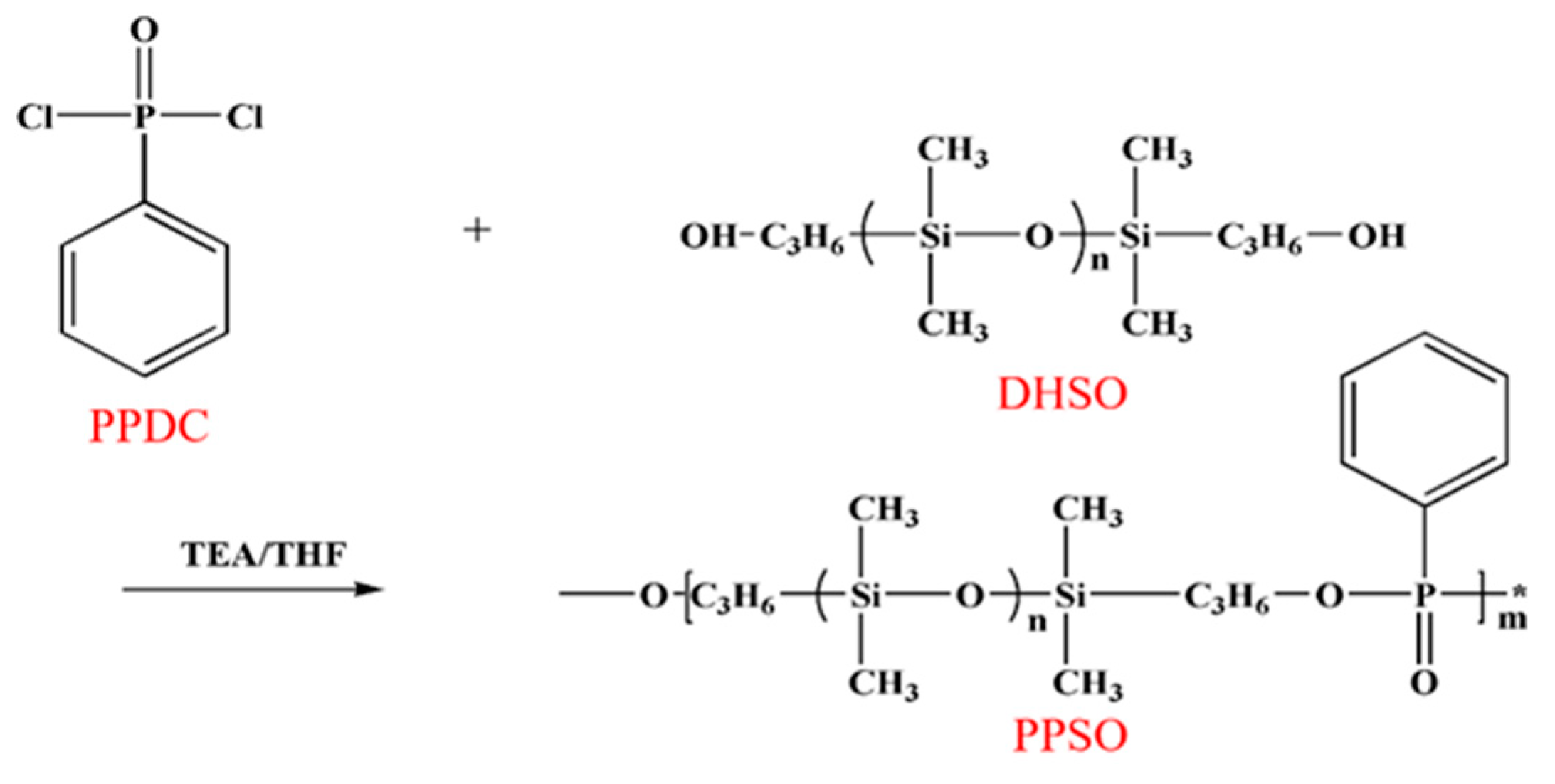
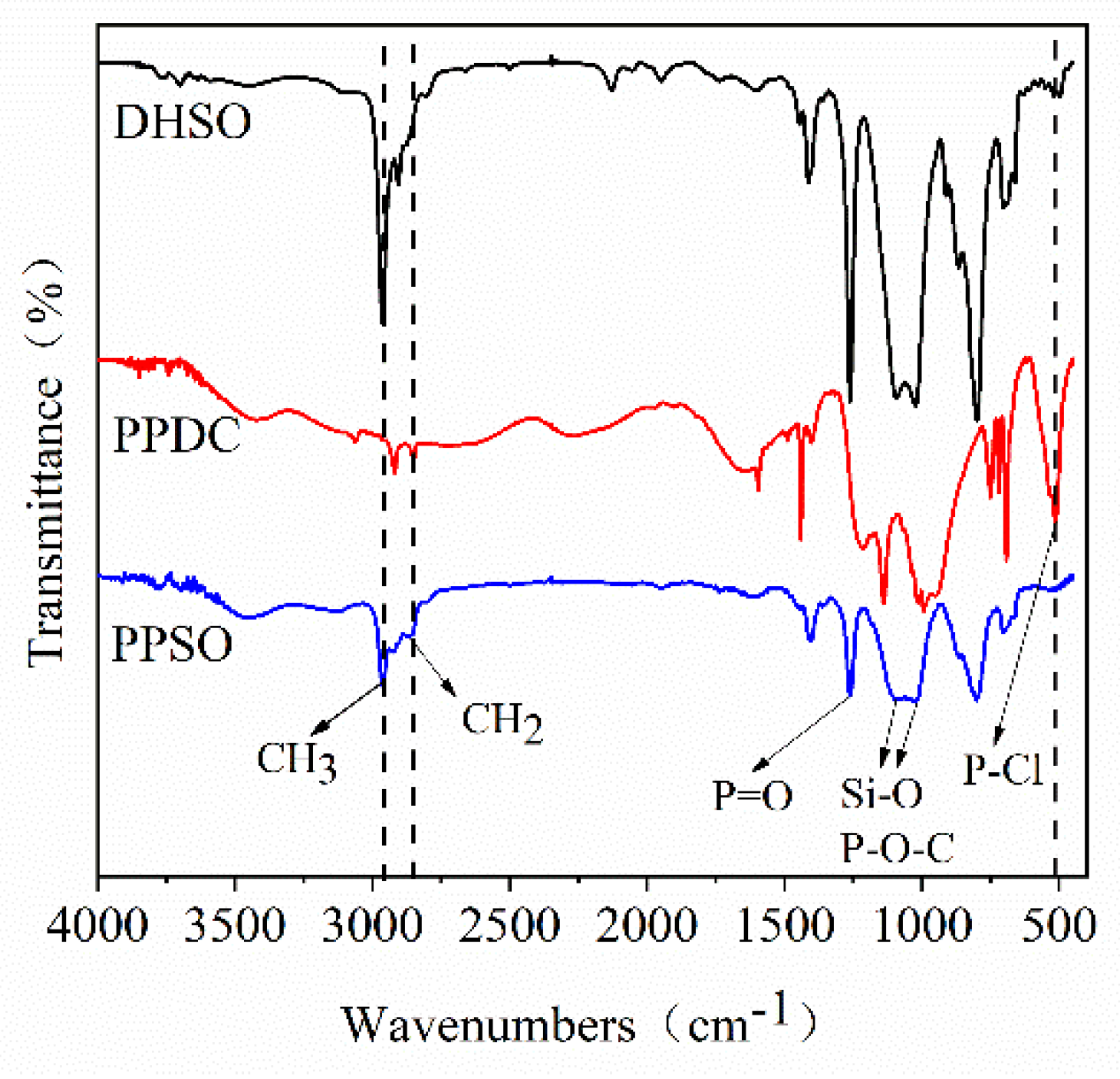
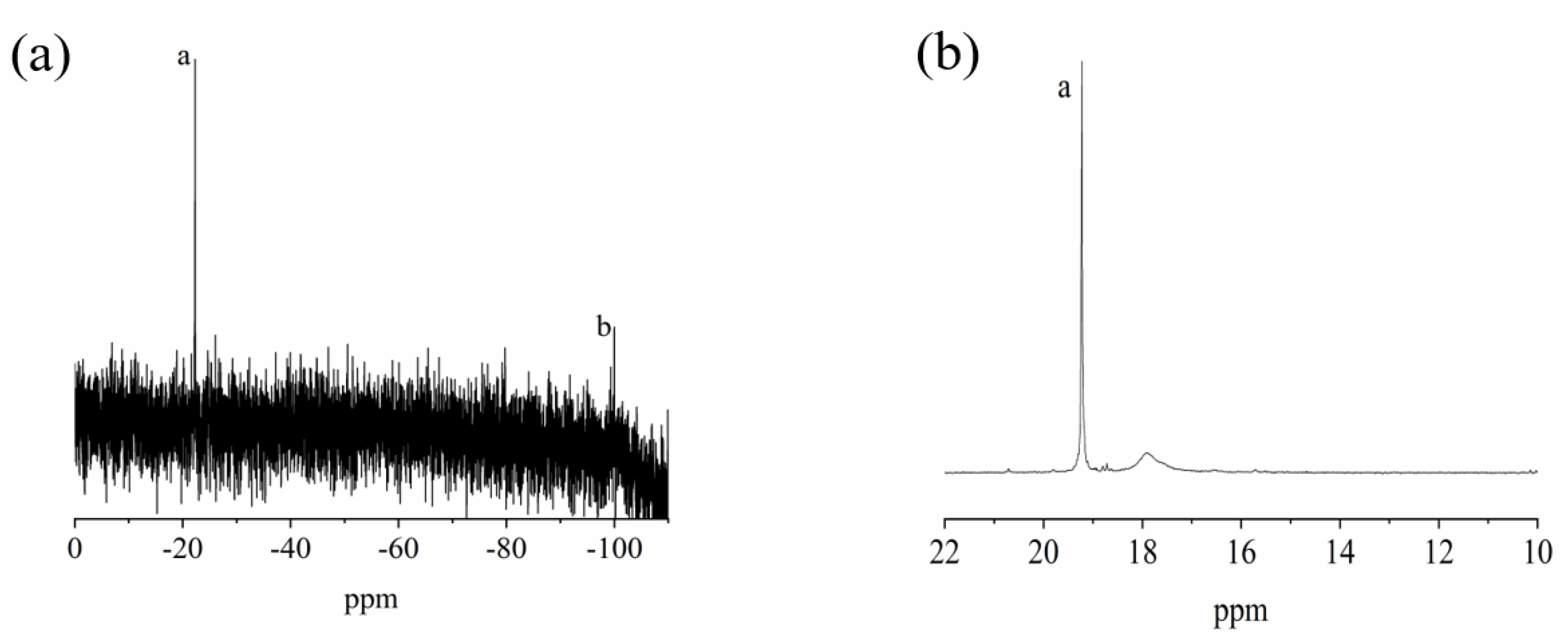
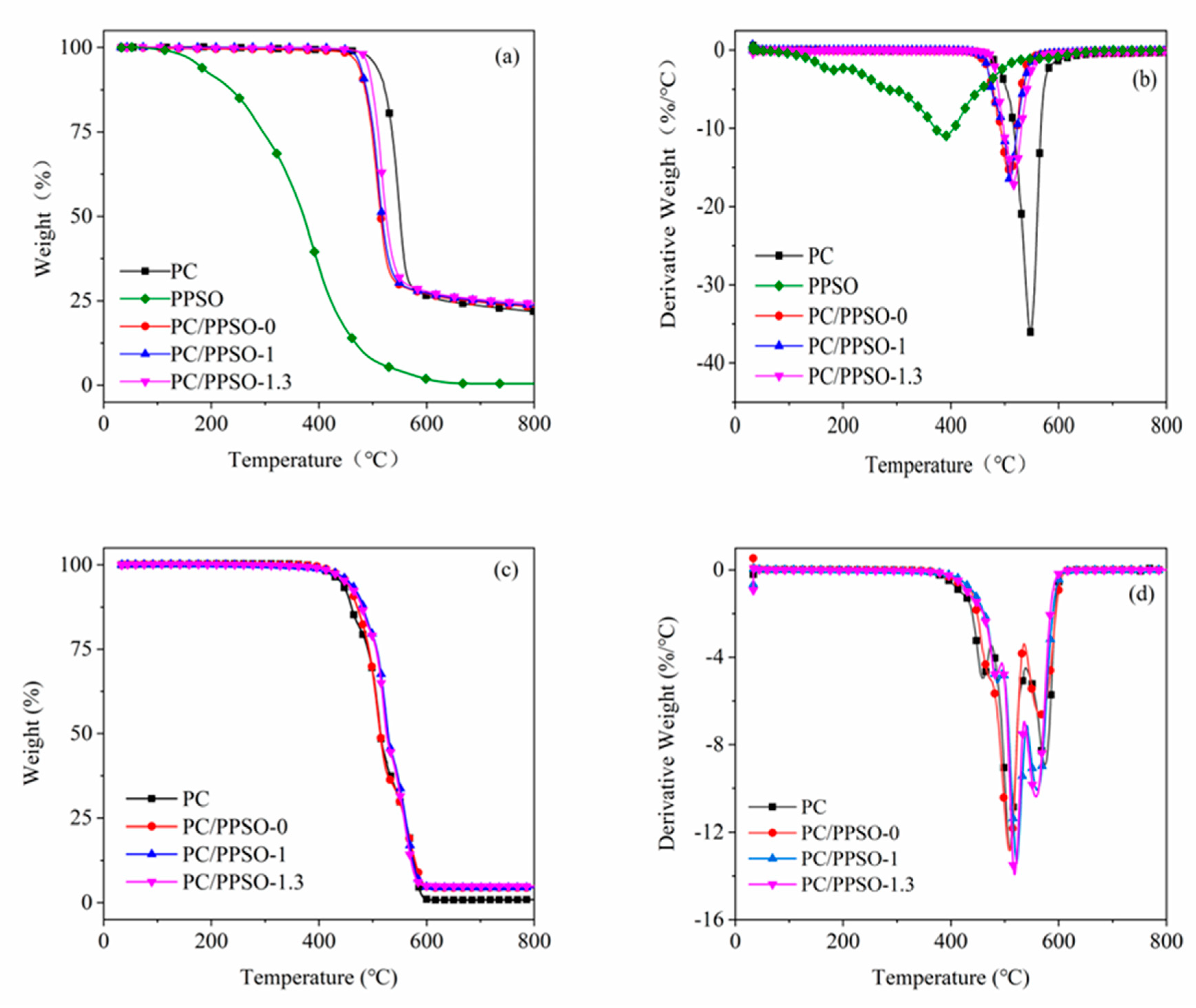
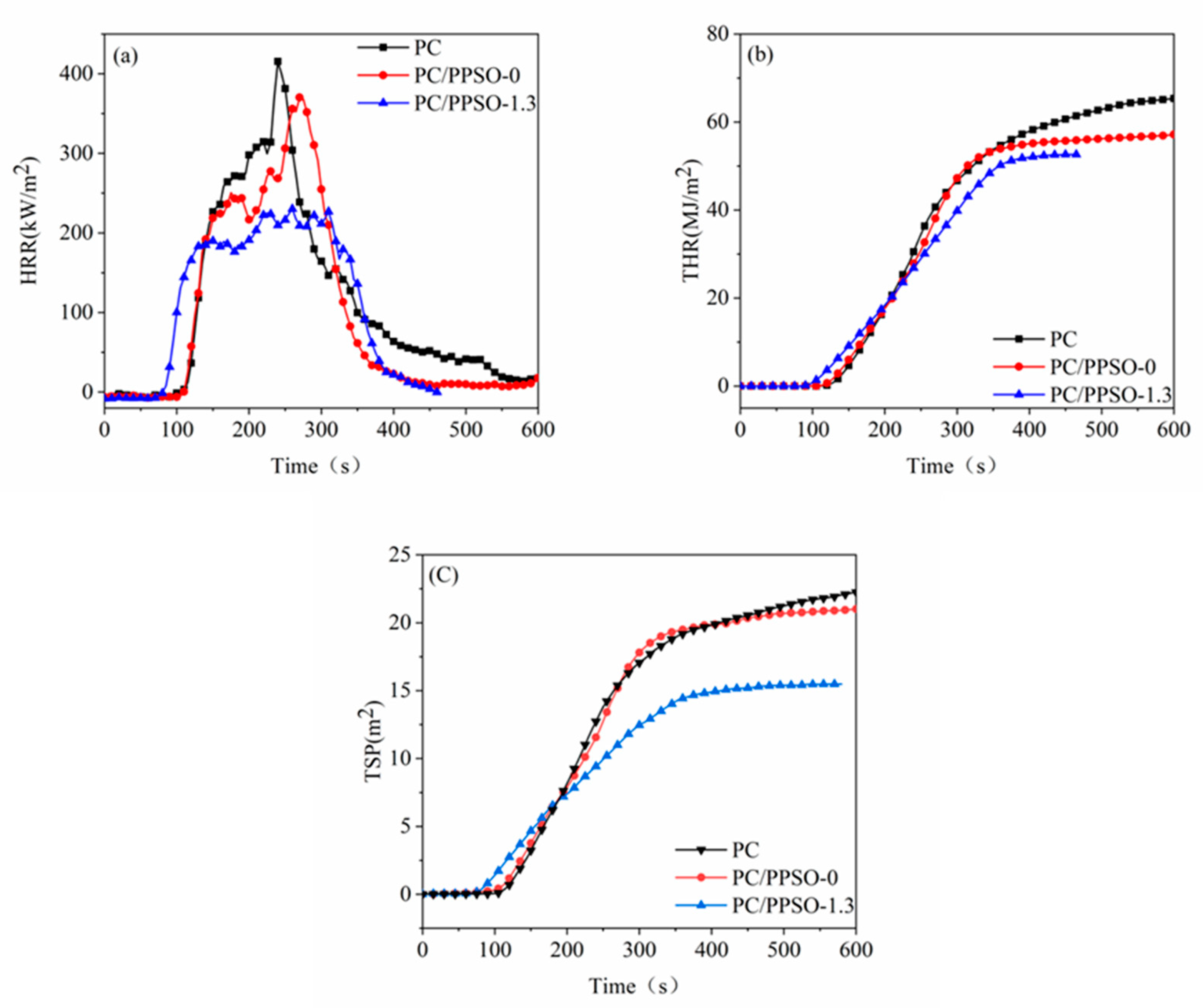
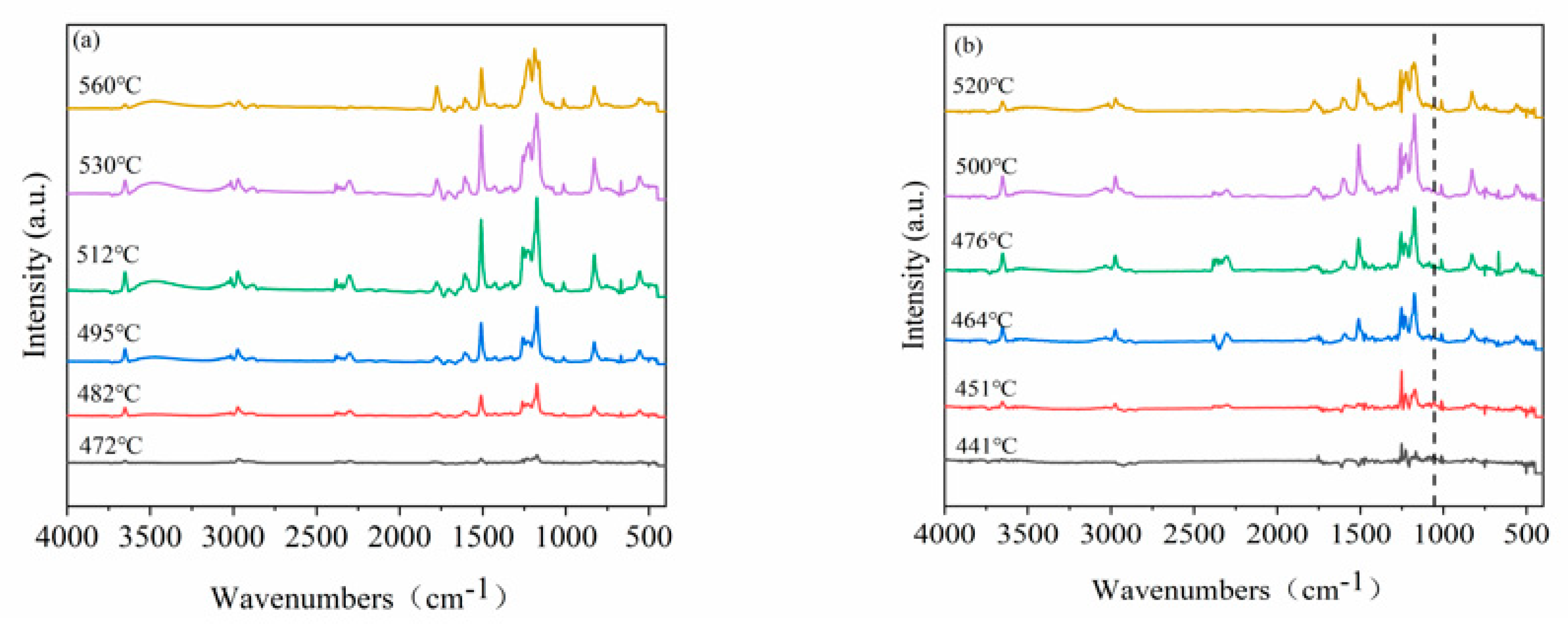
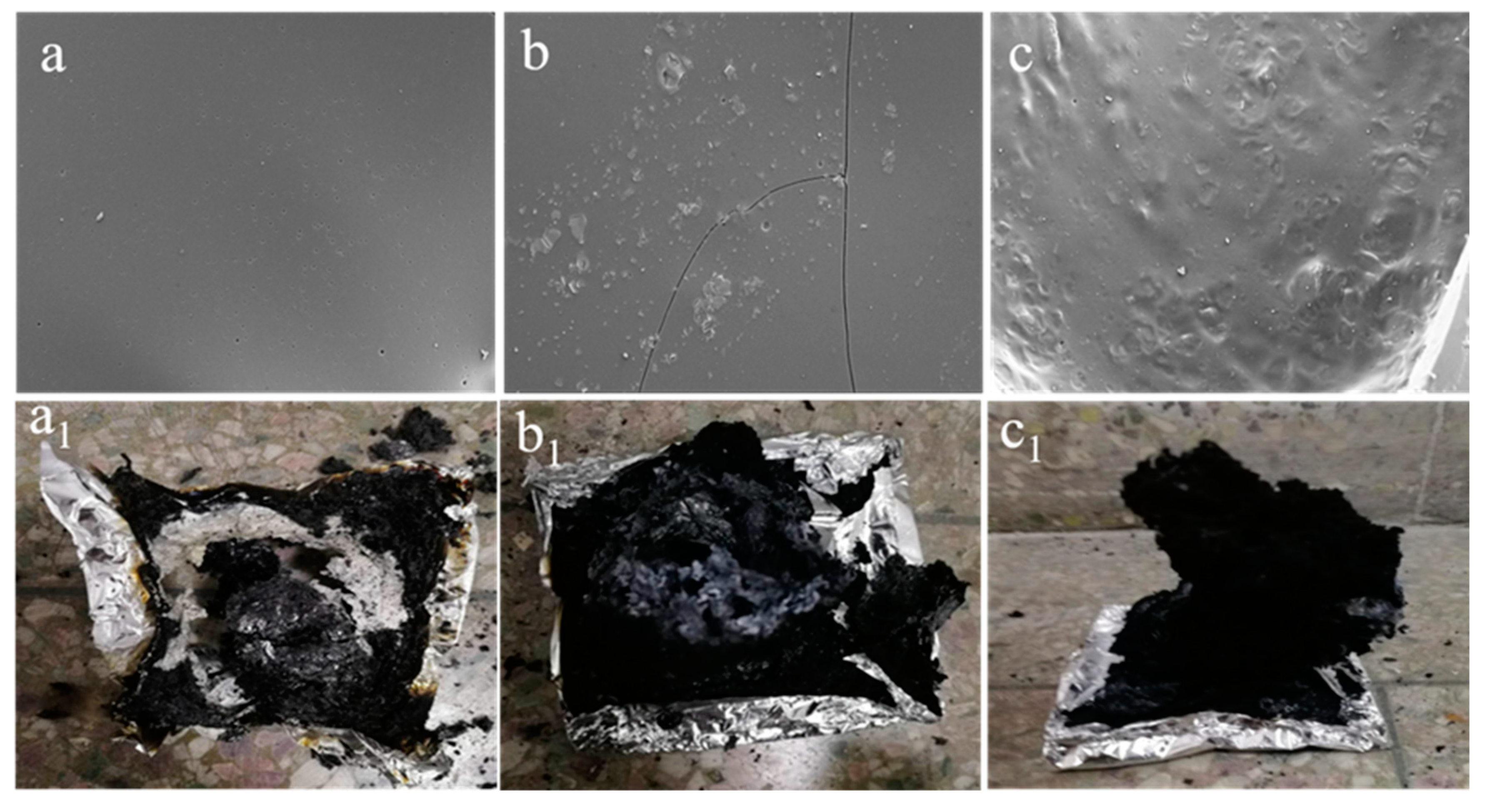
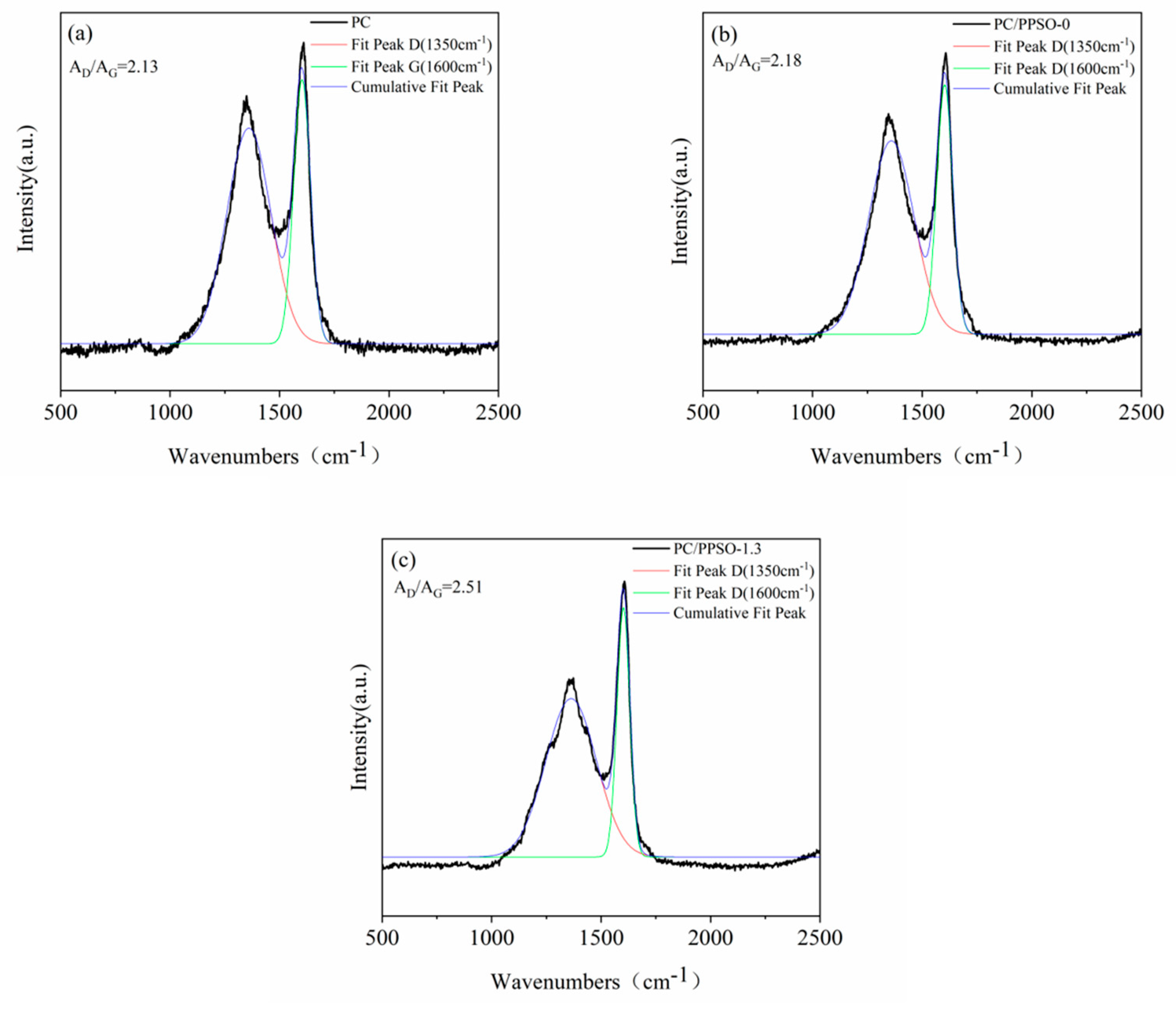
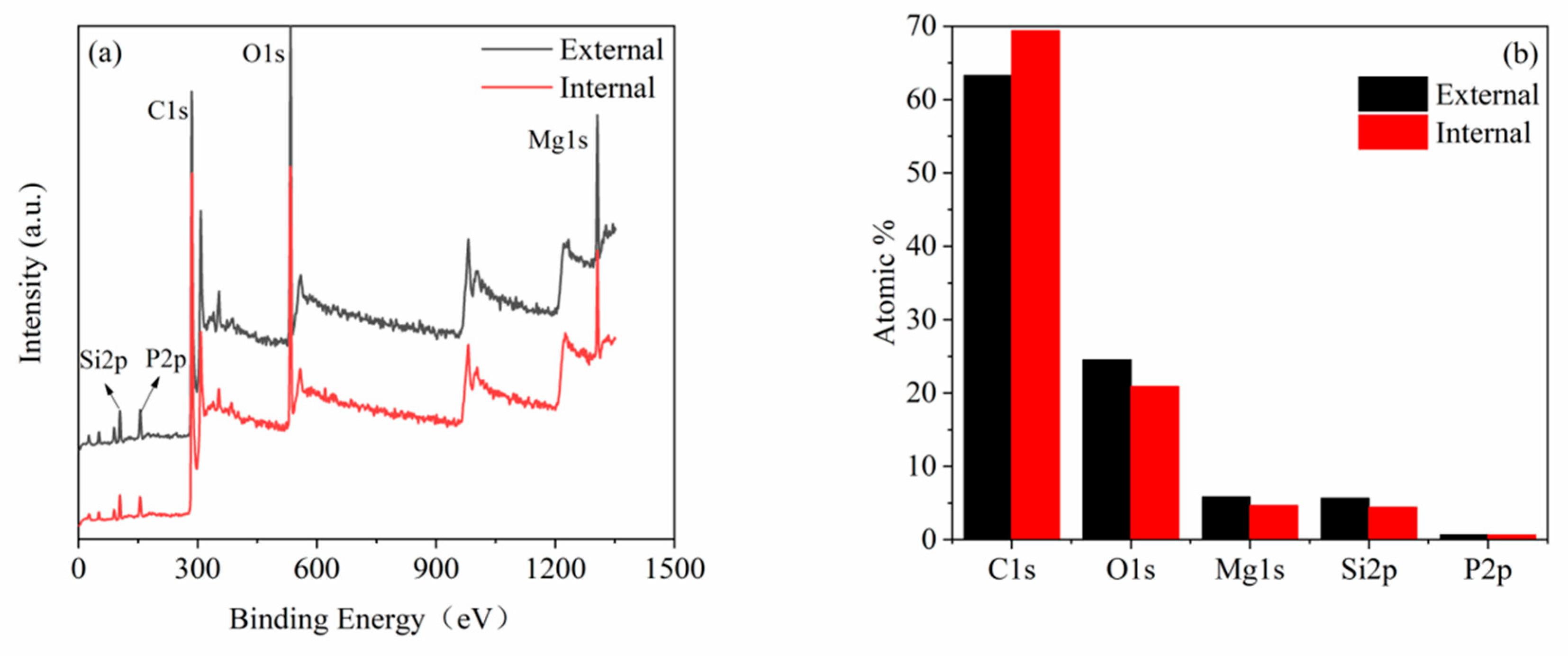

| Sample | PC (phr) | Talc (phr) | PPSO (phr) | LOI (%) | UL-94 Rating (2 mm) | Dripping or not |
|---|---|---|---|---|---|---|
| PC | 100 | 0 | 0 | 25 | V-2 | Yes |
| PC/PPSO-0 | 100 | 5 | 0 | 26 | V-2 | Yes |
| PC/PPSO-1 | 100 | 5 | 1 | 28 | V-1 | No |
| PC/PPSO-1.3 | 100 | 5 | 1.3 | 29 | V-0 | No |
| PC/PPSO-1.6 | 100 | 5 | 1.6 | 30 | V-0 | No |
| Sample | Nitrogen | Air | ||||||
|---|---|---|---|---|---|---|---|---|
| T5% (°C) | Tmax (°C) | Residues at 750 °C (%) | T5% (°C) | Tmax1 (°C) | Tmax2 (°C) | Tmax3 (°C) | Residues at 750 °C (%) | |
| PC | 504 | 549 | 22.6 | 440 | 459 | 509 | 575 | 0.8 |
| PC/PPSO-0 | 472 | 510 | 23.8 | 451 | 467 | 510 | 567 | 4.4 |
| PC/PPSO-1 | 476 | 509 | 24.2 | 455 | 487 | 522 | 561 | 4.5 |
| PC/PPSO-1.3 | 490 | 517 | 24.7 | 449 | 483 | 519 | 558 | 4.9 |
| Sample | PC | PC/PPSO-0 | PC/PPSO-1.3 |
|---|---|---|---|
| TTI (s) | 96 | 93 | 60 |
| PHRR (kw/m2) | 416 | 370 | 230 |
| tp-HRR (s) | 220 | 270 | 280 |
| THR (MJ/m2) | 65.6 | 62.5 | 52.6 |
| TSP (m2) | 27.1 | 21.6 | 15.4 |
| av-EHC (MJ/kg) | 20.1 | 18.9 | 17.9 |
| FPI | 0.23 | 0.25 | 0.26 |
| Sample | C1s (%) | O1s (%) | Mg1s (%) | Si2p (%) | P2p (%) |
|---|---|---|---|---|---|
| External | 63.28 | 24.52 | 5.84 | 5.69 | 0.68 |
| Internal | 69.36 | 20.90 | 4.67 | 4.40 | 0.66 |
© 2019 by the authors. Licensee MDPI, Basel, Switzerland. This article is an open access article distributed under the terms and conditions of the Creative Commons Attribution (CC BY) license (http://creativecommons.org/licenses/by/4.0/).
Share and Cite
Qiao, Y.; Wang, Y.; Zou, M.; Xu, D.; Pan, Y.; Luo, Z.; Wang, B. One-Step Synthesis of Highly Efficient Oligo(phenylphosphonic Dihydroxypropyl Silicone Oil) Flame Retardant for Polycarbonate. Polymers 2019, 11, 1977. https://doi.org/10.3390/polym11121977
Qiao Y, Wang Y, Zou M, Xu D, Pan Y, Luo Z, Wang B. One-Step Synthesis of Highly Efficient Oligo(phenylphosphonic Dihydroxypropyl Silicone Oil) Flame Retardant for Polycarbonate. Polymers. 2019; 11(12):1977. https://doi.org/10.3390/polym11121977
Chicago/Turabian StyleQiao, Yihui, Yanbin Wang, Menghao Zou, Dehuan Xu, Yingtong Pan, Zhonglin Luo, and Biaobing Wang. 2019. "One-Step Synthesis of Highly Efficient Oligo(phenylphosphonic Dihydroxypropyl Silicone Oil) Flame Retardant for Polycarbonate" Polymers 11, no. 12: 1977. https://doi.org/10.3390/polym11121977
APA StyleQiao, Y., Wang, Y., Zou, M., Xu, D., Pan, Y., Luo, Z., & Wang, B. (2019). One-Step Synthesis of Highly Efficient Oligo(phenylphosphonic Dihydroxypropyl Silicone Oil) Flame Retardant for Polycarbonate. Polymers, 11(12), 1977. https://doi.org/10.3390/polym11121977





